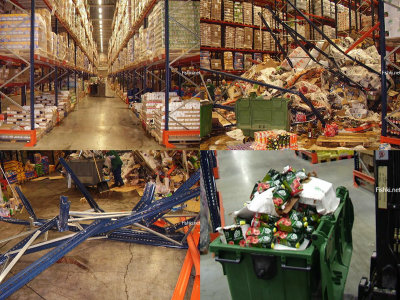Why is Amazon's subcontractor 'hanging your cell phone in a tree near your delivery location'?

Amazon operates a service called '
Amazon Drivers Are Hanging Smartphones in Trees to Get More Work-Bloomberg
https://www.bloomberg.com/news/articles/2020-09-01/amazon-drivers-are-hanging-smartphones-in-trees-to-get-more-work
Why Are Amazon Drivers Hanging Phones In Trees? Workers Take Desperate Measures To Get Ahead In Gig Economy
https://www.ibtimes.com/why-are-amazon-drivers-hanging-phones-trees-workers-take-desperate-measures-get-ahead-3038456
At Amazon's delivery station near Chicago and the grocery chain Whole Foods Market , you can see the strange sight of 'more than one cell phone hanging in a tree.' This seems to be done by people who work as Amazon subcontractors to increase the order rate of delivery requests.
This is a picture of 'a mobile phone is hanging on a tree', which was actually taken near Whole Foods Market in Evanston near Chicago. All mobile phones are located around Amazon's delivery base stations and stores, and the drivers participating in this operation are linking their mobile phones with the mobile phones hanging on the tree. That.
The bizarre reason Amazon drivers are hanging phones in trees near Whole Foods https://t.co/I4JLD84vru pic.twitter.com/kkXsu9vNy2
— Fortune Tech (@FortuneTech) September 1, 2020
A typical Amazon Flex driver can be assigned a delivery route of about 2 to 4 hours each time, but drivers who carry out a strategy of hanging a mobile phone on a tree can take about 15 minutes to 45 minutes each time. He said he is trying to receive an instant job.
Amazon uses a system that calculates 'drivers who are close to the delivery point' from the location information of the mobile phone when requesting an instant case to the registered driver. In urban areas where mobile phone radio waves are good and Wi-Fi spots are abundant, Amazon's system can detect mobile phone location information with an accuracy of within 20 feet (about 6 m). Therefore, by hanging a mobile phone on a tree near the delivery point, you can receive orders for instant projects without actually being near the delivery point.
The reason that Amazon Flex drivers carry out such extreme operations is the fact that a pandemic is causing the US unemployment rate to skyrocket. It's also good that Amazon Flex can work in free time, but now that many drivers use Amazon Flex as their main source of income, it is important to increase shipping orders even a little, Bloomberg said. Unlike fixed-paid full-time employees, drivers do not earn income without delivery, so it is important to win the delivery order as the first step.

Of course, the technique of 'hanging a mobile phone on a tree near the delivery base' is illegal, and some drivers who have not participated in the operation complain. Amazon says it is investigating this misconduct, but it says that the results of the investigation cannot be published.
According to a person who actually observed the driver performing this operation, the cell phone hanging on the tree is not linked only to a specific individual, but assigns delivery to multiple drivers participating in the operation It is functioning as '. It is believed that there may be a system where individuals and groups hanging mobile phones make a leap as an intermediary between Amazon and the driver and instead collect delivery orders from drivers participating in the operation, instead of collecting fees from the driver ..
Wireless industry consultant Chetan Sharma pointed out that the culprit probably has multiple Amazon Flex accounts. It seems that the fraud detection system may be bypassed by distributing the delivery orders to multiple accounts.
Also, Amazon Flex drivers may not be the only reason to participate in this strategy, simply to increase order rates. Since the Amazon Flex account used in this operation is different from the actual driver, it is possible for 'a person who does not have a valid license or work permit in the United States' to work as a subcontracted driver I will. An anonymous information provider told Bloomberg that there are cases where the account owner received an order for $ 18 (about 1900 yen) delivery and let the actual driver deliver for $ 10 (about 1060 yen). It was

Related Posts:
in Note, Posted by log1h_ik







